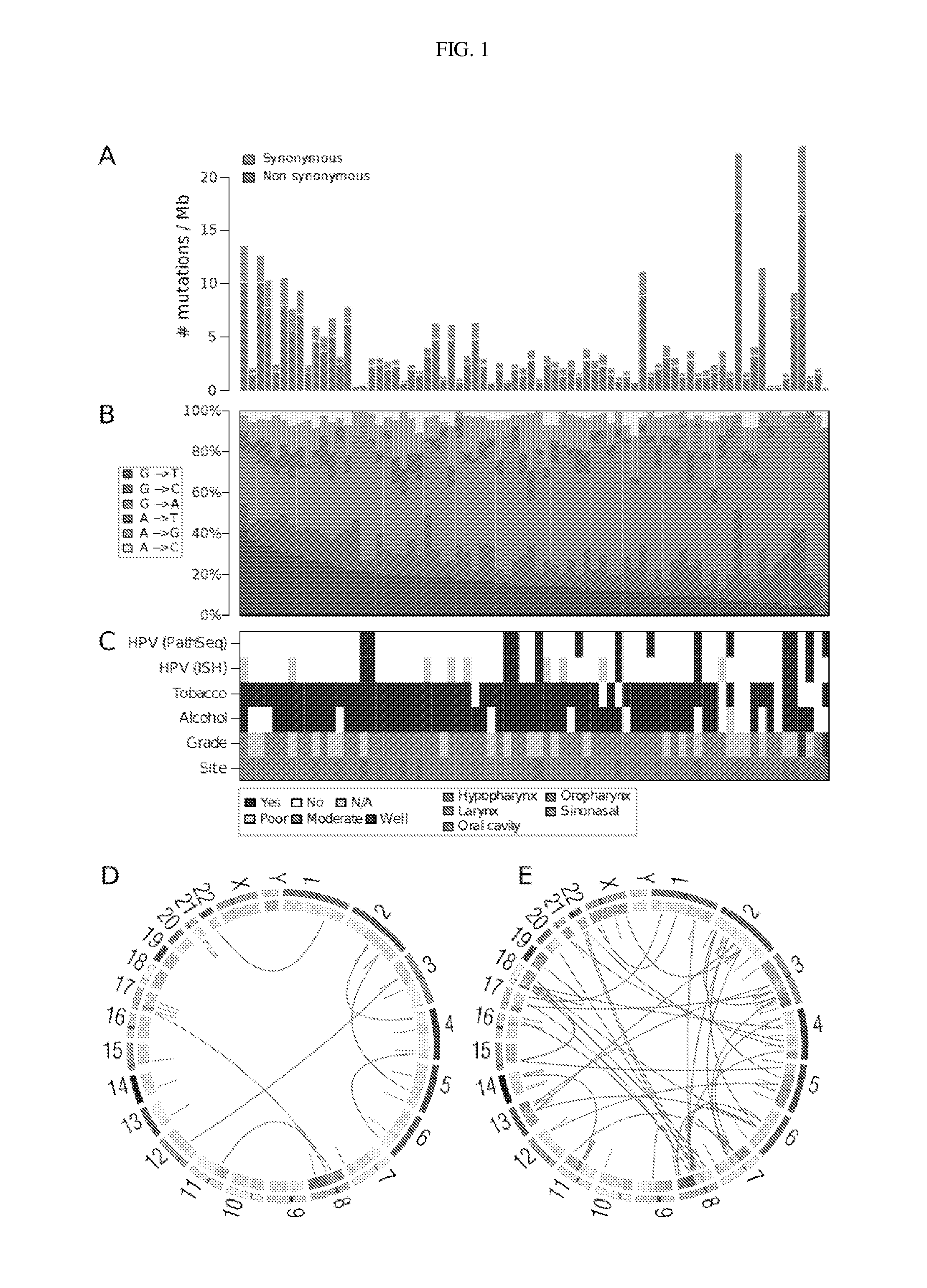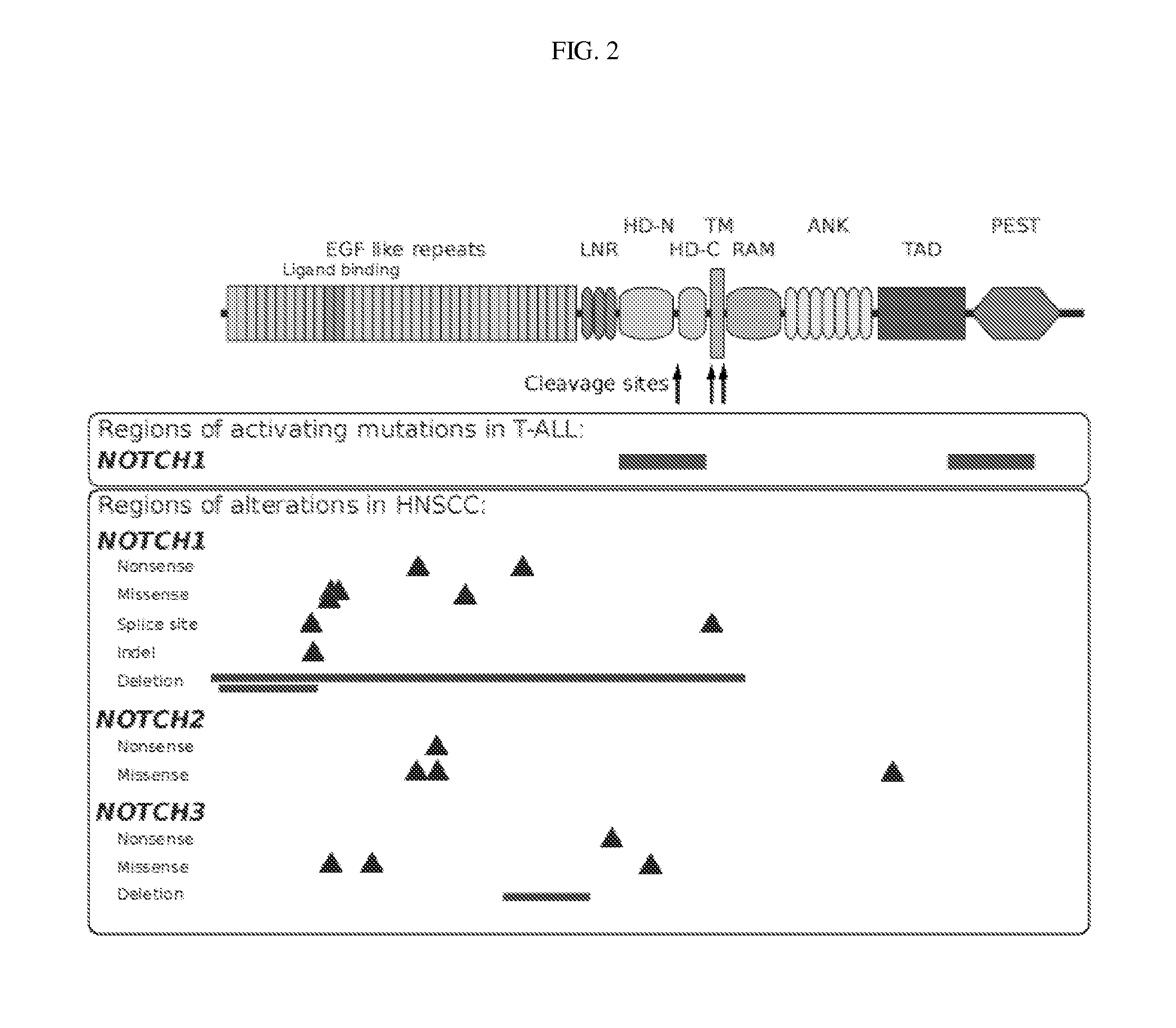Compositions And Methods Of Treating Head And Neck Cancer
a technology of compositions and methods, applied in the field of head and neck cancer, can solve the problems that the survival rate of many types of hnscc has not improved in the past forty years, and achieves the effect of improving the survival rate of many types of hns
- Summary
- Abstract
- Description
- Claims
- Application Information
AI Technical Summary
Benefits of technology
Problems solved by technology
Method used
Image
Examples
example 1
Materials and Methods
[0137]Clinical, Pathologic and Risk Exposure Information
[0138]Patient data that included tumor histology, type (primary versus recurrent), anatomical site / grade, tumor / nodal disease stage, and treatment history (e.g., prior radiotherapy or chemoradiotherapy) were obtained through the University of Pittsburgh Head and Neck SPORE neoplasm virtual repository (35), a database curated and maintained by the University of Pittsburgh Head and Neck Cancer Registrar. Patient tobacco and alcohol use histories and data were obtained through administered questionnaire or clinical chart review.
[0139]Samples.
[0140]Samples and clinical information were collected from consented patients and processed using protocols approved by the Institutional Review Boards of the University of Pittsburgh and the Broad Institute of MIT and Harvard. Patients diagnosed with pathologically confirmed squamous cell carcinoma of the oral cavity, oropharynx, hypopharynx, nasopharynx, nasal cavity and...
example 2
Sequence Data Generation
[0149]Quality Assessment of DNA and Tumor Purity
[0150]Concentrations of tumor and normal DNA were measured using PicoGreen® dsDNA Quantitation Reagent (Invitrogen, Carlsbad, Calif.). Applicants required a minimum DNA concentration of 60 ng / μL for sequencing. DNA sample quality was assessed by gel electrophoresis. Applicants prepared reserve stocks of each sample using whole genome amplification (WGA) for use in subsequent validation efforts, though the Illumina sequencing libraries were created with the native DNA. The identities of all tumor and normal DNA samples (native and WGA product) were confirmed by mass spectrometric fingerprint genotyping of 24 common SNPs (Sequenom, San Diego, Calif.). Finally, a subset of the tumor DNAs were hybridized to genome-wide human SNP microarrays (Affymetrix SNP Array 6.0) and analyzed as described previously (38). Samples having favorable expected statistical power for the detection of somatic point mutations were select...
example 3
Sequence Data Processing
[0163]Massively parallel sequencing data were processed using two consecutive pipelines. The sequencing data processing pipeline, called “Picard”, developed by the Sequencing Platform at the Broad Institute, starts with the reads and qualities produced by the Illumina software for all lanes and libraries generated for a single sample (either tumor or normal) and produces, at the end of the pipeline, a single BAM file (available as a pdf file titled SAM1 on the website of samtools at a sourceforge dot net extension) representing the sample. The final BAM file stores all reads with well-calibrated qualities together with their alignments to the genome (only for reads that were successfully aligned).
[0164]The Broad Cancer Genome Analysis pipeline, also known as “Firehose”, starts with the BAM files for the tumor and matched normal samples and performs various analyses, including quality control, local realignment, mutation calling, small insertion and deletion i...
PUM
| Property | Measurement | Unit |
|---|---|---|
| Composition | aaaaa | aaaaa |
| Gene expression profile | aaaaa | aaaaa |
| Chemotherapeutic properties | aaaaa | aaaaa |
Abstract
Description
Claims
Application Information
 Login to View More
Login to View More - R&D
- Intellectual Property
- Life Sciences
- Materials
- Tech Scout
- Unparalleled Data Quality
- Higher Quality Content
- 60% Fewer Hallucinations
Browse by: Latest US Patents, China's latest patents, Technical Efficacy Thesaurus, Application Domain, Technology Topic, Popular Technical Reports.
© 2025 PatSnap. All rights reserved.Legal|Privacy policy|Modern Slavery Act Transparency Statement|Sitemap|About US| Contact US: help@patsnap.com



